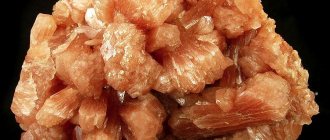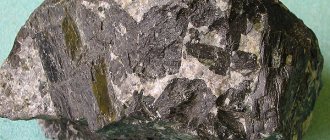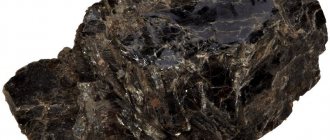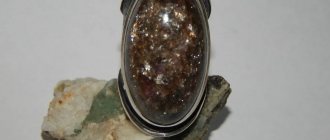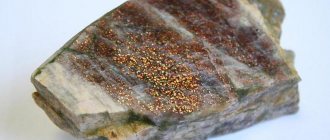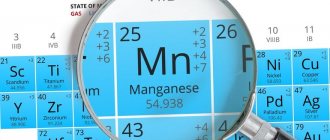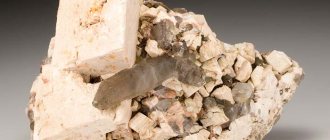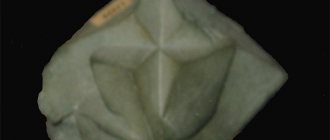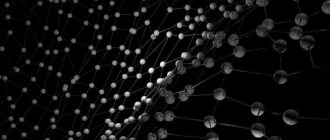The microcline mineral is very common and belongs to the feldspar family, in particular the calcium group. It is often found next to orthoclase, sanidine, and kokchetavite. Translated from Greek as “small corner”.
The mineral microcline is very common and is part of the feldspar family, in particular the calcium group
Microcline is a rock-forming mineral of the aluminosilicate class: potassium aluminosilicate (silicate).
The stone received its name thanks to a German scientist who discovered a microscopic deviation from the right angle between the cleavage planes, which is half a degree.
Description of the mineral
Characteristics:
- The mineral has a glassy luster, with a pearlescent tint, as well as matte weathered variations.
- This is a dense and hard material. When it comes into contact with glass, it leaves a mark.
- May have white, red, yellow, brown green and grayish tones.
- Weathered layers leave white streaks.
- The cleavage is absolute, directed in two directions.
- An angle slightly less than a right angle is formed between the cleavage planes.
- Drusen and crystals are rare and are usually visually similar to orthoclase. Microcline and orthoclase can only be distinguished under a microscope.
- Mineral crystals can grow into other rocks and grow on them.
- Inherent non-metallic luster.
- Microcline is also similar to quartz; they can be distinguished from each other by the presence of ideal cleavage.
- Unaffected by acids.
How to distinguish from a fake
Microcline is often confused with a stone with similar external characteristics - orthoclase. Unfortunately, in order not to come across a fake and mistakenly purchase orthoclase, you will have to resort to the help of professionals, since these minerals can only be distinguished by microscopic examination.
The main distinctive features of microcline are:
- Non-metallic luster;
- High level of hardness (capable of leaving scratches on glass);
- Ability for iridescence.
Types of stone
There are several types of mineral:
We also recommend reading:
The history and curse of the Kohinoor stone The marvelous ametrine stone Characteristics of larimar and its main properties Selection of stones by date of birth
- Green microcline (turquoise shades). It is called amazonite or Amazonian stone. The name is similar to the name of the Amazon River, although the stone is not associated with it. Previously it was believed that it was first mined in the basin of the greatest river in South America. Then it turned out that the discovered crystals, considered Amazonites, actually turned out to be jades.
- Graphic pegmatite. One of the variants of potassium feldspar, the specificity of which is the correct arrangement of ingrown quartz crystals. And in cross-section it looks like Arabic or Jewish hieroglyphs, which is why it got the name “Jewish stone”.
- Heliolite. A very bright and warm mineral, it can be transparent or slightly cloudy. Painted in orange, crimson, golden shades. Visually similar to aventurine quartz, but if you compare them, heliolite has a granular structure and high fragility.
- Aventurine feldspar. Cloudy golden heliolite with orange, red, honey or pink hues.
Physico-chemical characteristics
The chemical formula of microcline is complex, as is its composition.
For a chemist, it is a silicate. Minerologists classify the stone as potassium feldspars of hydrothermal or metamorphic origin.
| Color | colorless, white, gray, grayish-yellow, yellowish, tan, salmon pink, brownish-red, bluish-green, green, sometimes iridescent |
| Stroke color | white |
| origin of name | From the Greek micro - small and wedge - angle, since the cleavage angle of a microcline differs from a right angle by only 20′ |
| Opening place | Arendal, Aust-Agder, Norway Stavern (Fredriksvärn), Larvik, Vestfold, Norway |
| Opening year | 1830 |
| IMA status | valid, first described before 1959 (before IMA) |
| Chemical formula | K[AlSi3O8] |
| Shine | glass |
| Transparency | transparent translucent translucent |
| Cleavage | perfect by {001} perfect by {010} |
| Kink | uneven |
| Hardness | 6 6,5 |
| Thermal properties | P. tr. melts with difficulty |
| Typical impurities | Fe,Ca,Na,Li,Cs,Rb,H2O,Pb |
| Strunz (8th edition) | 8/J.06-30 |
| Hey's CIM Ref. | 16.3.5 |
| Dana (8th edition) | 76.1.1.5 |
| Molecular weight | 278.33 |
| Cell Options | a = 8.5784Å, b = 12.96Å, c = 7.2112Å α = 90.3°, β = 116.05°, γ = 89° |
| Attitude | a:b:c = 0.662 : 1 : 0.556 |
| Number of formula units (Z) | 4 |
| Unit cell volume | V 720.16 ų |
| Twinning | Carlsbad, Baven, polysynthetic twins. Characteristic are intersecting polysynthetic systems. dv. according to the albite and pericline laws, forming the so-called. micro wedge grid |
| Point group | 1 – Pinacoidal |
| Space group | C/1 |
| Separateness | by {100}, {110}, {110}, {201} |
| Radioactivity (GRapi) | 200.97 |
| Density (calculated) | 2.56 |
| Density (measured) | 2.54 – 2.57 |
| Optical axis dispersion | r > v weak |
| Refractive indices | nα = 1.514 – 1.529 nβ = 1.518 – 1.533 nγ = 1.521 – 1.539 |
| Maximum birefringence | δ = 0.007 – 0.010 |
| Type | biaxial (-) |
| angle 2V | measured: 66° to 103°, calculated: 80° |
| Optical relief | short |
| Selection form | short-prismatic or tabular crystals, often of considerable size, granular masses, phenocrysts, ovoids; graphic intergrowths with quartz |
| Classes on taxonomy of the USSR | Silicates |
| IMA classes | Silicates |
| singonia | triclinic |
| Fragility | Yes |
| Irisation | Yes |
Impurities create a color palette.
Storage locations
Microclines are encountered in pegmatite veins, as this is the most natural location for this mineral. Associated breeds are:
- Granite pegmatites contain quartz, albite, mica, topaz, and beryl.
- In pegmatites of nepheline syenites there is nepheline.
- Products of chemical weathering – kaolinite.
Microcline is a rock-forming mineral of the aluminosilicate class: potassium aluminum silicate.
Pegmatite veins are located on the western coast of the White Sea (North Karelia). They contain spar, quartz, and mica. Bright rich green microcline is mined on the Kola Peninsula. Its deposits are also known in Eastern Siberia. Numerous underground deposits were discovered in the Urals, in the Ilmen Mountains region, in Ukraine, Germany, Switzerland, Kazakhstan, Norway, Poland, the USA, Japan, and Madagascar.
Areas where feldspar can be mined are located in the Czech Republic (Karlovy Vary) and Italy (Baveno).
Usage
Potassium feldspars are used in the ceramic and glass industries: in the production of porcelain, earthenware, enamels, and glazes. Amazonite is used as construction and ornamental raw materials. Often used as a source of cesium and rubidium - metals from the rare earth group.
Pure and rare specimens are not used for jewelry purposes; they have collection value. Crafts and jewelry are made from some varieties of microcline. Turquoise Amazonite is a material for making beads, earrings, bracelets, rings and pendants. Amazonite and aventurine spar are suitable for the production of vases, boxes, figurines and other interior items.
Heliolite is very rarely used in jewelry and stone cutting. This is a very rare and exclusive specimen that is not inferior to other gems. Graphic pegmatite is excellent for processing, after which it becomes a ball and cabochon.
Where is it used?
The mineral microcline has found application in industry, jewelry and decorative arts:
- Opaque raw materials are used as a source of glass, ceramics, and electrode coating. It is valued by manufacturers of tableware, industrial products (insulators), and dentists (fillings, crowns).
- Amazonite is used to make tiles, slabs for window sills and mantelpieces. But wealthy people can buy them.
- The best samples go to jewelers. The stone is processed into a cabochon, turning beads for necklaces, bracelets, and rosaries. Products made from microcline with iridescence and emerald green amazonites are prized.
Amazonite ring
Well-formed microcline crystals with quartz inclusions are a collector's dream. Because of its patterned surface, this stone is known as “written” granite. Connoisseurs are not deterred by its exorbitant price or rarity. A classic of collectible art – amazonite intergrowths with smoky quartz.
Healing and magical properties
Microcline has a wide range of therapeutic effects.
Properties are considered depending on the type of mineral. Amazonite is used to rejuvenate the body. It helps with arthritis, osteochondrosis, rheumatism. If you use the stone for massage, you can use it to cleanse blood vessels, cure varicose veins, and completely improve the functioning of the cardiovascular system. The medicinal properties of the stone can be used to prevent attacks of epilepsy, eliminate depression, weakness, impotence, and nervous exhaustion.
Amazonite is considered an excellent amulet for married couples, as it improves the situation in love relationships, instills respect and trust. Can be used in magical rituals to acquire good health and restore youth. This stone requires a respectful and careful attitude, otherwise it is capable of turning all the negative qualities of its owner against him.
The effects of heliolite are similar to amazonite. But to this you can add the ability to cleanse the blood, restore vision and free the body from neurological problems. It relieves fatigue, fears, and worries. The wearer of the stone becomes calmer and more confident. Heliolite stimulates imagination and promotes the release of emotions.
The healing qualities of graphic pegmatite have not been studied at all. But its magical power lies in protecting family and home comfort. He helps educators and teachers. It has a beneficial effect on the mental process, increases productivity, attracts luck and material resources.
The use of aventurine feldspar is a very effective method for restoring vision and treating skin diseases. This stone always gives a great mood. Attracts good luck, helps to get rich. But he cannot stand lies, deception and uncertainty.
Influence on zodiac signs
All varieties of microcline have powerful energy and, if chosen correctly, can become a strong zodiac amulet for a person. Sunstone and pegmatite are suitable for all signs without exception. But Amazonite is most favorable to Taurus, Aries, Cancer and Scorpio. It allows representatives of these zodiac signs to become more self-confident, attracting good luck, love and wealth to them.
Sagittarians should not wear products with Amazonian stone, as it can cause harm to them.
Heliolite protects fire, so representatives of the fire element - Aries, Leo and Sagittarius - should choose it as an amulet. For people born under these zodiac signs, the stone will give additional strength and protect them from negative emotions. Heliolite is contraindicated for Pisces, Cancers and Scorpios. Its destructive energy can deprive representatives of these signs of vitality and bring them into trouble.
